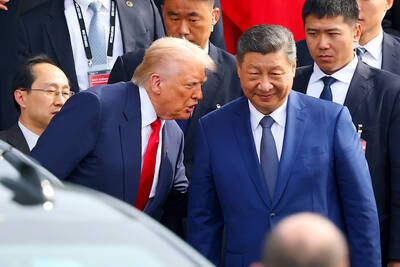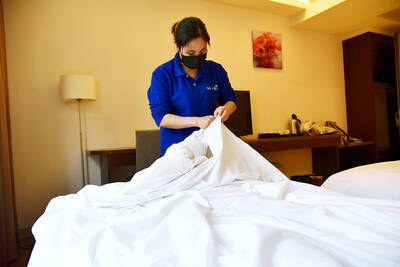Taiwan has started negotiations with the US regarding the procurement of 66 F-16 fighter aircraft in order to strengthen its national defense, Deputy Minister of National Defense Ko Cheng-heng (
Ko's comments appeared in an interview published in Japan's Nihon Keizai Shimbun yesterday.
Ko was quoted by the newspaper as saying that the arms purchase bill passed by the legislature in the middle of last month -- which included funds for the acquisition of 12 P-3C anti-submarine aircraft -- would help narrow the gap in military capacity between Taiwan and China.
Ministry of National Defense estimates show that the arms purchase will help maintain a ratio in military capabilities of 1:1.67 between Taiwan and China until 2035.
This ratio, Ko said, would allow Taiwan to defend itself.
The legislature has already made it clear it will pass a classified budget for the purchase of 66 F16C/D fighter jets, pending approval by the US, he said.
The F16C/D is an improved version of the 146 F16A/B fighter aircraft Taiwan currently has in its fleet.
Ko said the aircraft carrier that China plans to develop is not necessary for launching an attack on Taiwan.
Instead, Ko said, the buildup is incontrovertible evidence that China is trying to use its military expansion to develop into a global power.
The ministry has determined that since the beginning of this year, Beijing has increased its military activities in the East China Sea, Ko said.
Chinese military ships and aircraft have also appeared more frequently in the waters and airspace east of Taiwan since the beginning of this year, probably to collect intelligence, Ko said.
Ko expressed his hope for expanded military exchanges between Taiwan and Japan and praised the defense white paper recently issued by Tokyo.
He was referring to the report issued on Friday by the Japanese Defense Ministry.
The report expressed concerns over a lack of transparency in China's fast-growing military spending.
It also stated that China's military buildup was more ambitious than what would be required for it to enter into military conflict with Taiwan.
The annual report, approved by Japanese Prime Minister Shinzo Abe's Cabinet, argued that China's buildup of its navy and air force -- in addition to its interest in acquiring aircraft carrier capability -- was to enable it to project force outside its immediate boundaries.
The report also warned that North Korea has been improving its missile system so that it could cover all of east Asia and potentially reach the northern tip of Australia as well as part of Alaska.

CALL FOR SUPPORT: President William Lai called on lawmakers across party lines to ensure the livelihood of Taiwanese and that national security is protected President William Lai (賴清德) yesterday called for bipartisan support for Taiwan’s investment in self-defense capabilities at the christening and launch of two coast guard vessels at CSBC Corp, Taiwan’s (台灣國際造船) shipyard in Kaohsiung. The Taipei (台北) is the fourth and final ship of the Chiayi-class offshore patrol vessels, and the Siraya (西拉雅) is the Coast Guard Administration’s (CGA) first-ever ocean patrol vessel, the government said. The Taipei is the fourth and final ship of the Chiayi-class offshore patrol vessels with a displacement of about 4,000 tonnes, Lai said. This ship class was ordered as a result of former president Tsai Ing-wen’s (蔡英文) 2018

UKRAINE, NVIDIA: The US leader said the subject of Russia’s war had come up ‘very strongly,’ while Jenson Huang was hoping that the conversation was good Chinese President Xi Jinping (習近平) and US President Donald Trump had differing takes following their meeting in Busan, South Korea, yesterday. Xi said that the two sides should complete follow-up work as soon as possible to deliver tangible results that would provide “peace of mind” to China, the US and the rest of the world, while Trump hailed the “great success” of the talks. The two discussed trade, including a deal to reduce tariffs slapped on China for its role in the fentanyl trade, as well as cooperation in ending the war in Ukraine, among other issues, but they did not mention

HOTEL HIRING: An official said that hoteliers could begin hiring migrant workers next year, but must adhere to a rule requiring a NT$2,000 salary hike for Taiwanese The government is to allow the hospitality industry to recruit mid-level migrant workers for housekeeping and three other lines of work after the Executive Yuan yesterday approved a proposal by the Ministry of Labor. A shortage of workers at hotels and accommodation facilities was discussed at a meeting of the legislature’s Transportation Committee. A 2023 survey conducted by the Tourism Administration found that Taiwan’s lodging industry was short of about 6,600 housekeeping and cleaning workers, the agency said in a report to the committee. The shortage of workers in the industry is being studied, the report said. Hotel and Lodging Division Deputy Director Cheng

‘SECRETS’: While saying China would not attack during his presidency, Donald Trump declined to say how Washington would respond if Beijing were to take military action US President Donald Trump said that China would not take military action against Taiwan while he is president, as the Chinese leaders “know the consequences.” Trump made the statement during an interview on CBS’ 60 Minutes program that aired on Sunday, a few days after his meeting with Chinese President Xi Jinping (習近平) in South Korea. “He [Xi] has openly said, and his people have openly said at meetings, ‘we would never do anything while President Trump is president,’ because they know the consequences,” Trump said in the interview. However, he repeatedly declined to say exactly how Washington would respond in